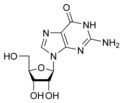- Nucleobase
-
Nucleobases are a group of nitrogen-based molecules that are required to form nucleotides, the basic building blocks of DNA and RNA. Nucleobases provide the molecular structure necessary for the hydrogen bonding of complementary DNA and RNA strands, and are key components in the formation of stable DNA and RNA molecules.
Nucleobases (or nucleotide bases/nitrogenous bases/aglycones) provide the nucleotide structure necessary to form base pairs. The primary nucleobases are cytosine, guanine, adenine (DNA and RNA), thymine (DNA) and uracil (RNA), abbreviated as C, G, A, T, and U, respectively. They are usually simply called bases in genetics. Because A, G, C, and T appear in the DNA, these molecules are called DNA-bases; A, G, C, and U are called RNA-bases.
Uracil replaces thymine in RNA. These two bases are identical except that uracil lacks the 5' methyl group. Adenine and guanine belong to the double-ringed class of molecules called purines (abbreviated as R). Cytosine, thymine, and uracil are all pyrimidines (abbreviated as Y).
The compound formed when a nucleobase forms a glycosidic bond with the 1' anomeric carbon of a ribose or deoxyribose is called a nucleoside, and a nucleoside with one or more phosphate groups attached at the 5' carbon is called a nucleotide.
Apart from adenine (A), cytosine (C), guanine (G), thymine (T) and uracil (U), DNA and RNA also contain bases that have been modified after the nucleic acid chain has been formed. In DNA, the most common modified base is 5-methylcytosine (m5C). In RNA, there are many modified bases, including those contained in the nucleosides pseudouridine (Ψ), dihydrouridine (D), inosine (I), and 7-methylguanosine (m7G).[1][2]
Hypoxanthine and xanthine are two of the many bases created through mutagen presence, both of them through deamination (replacement of the amine-group with a carbonyl-group). Hypoxanthine is produced from adenine, xanthine from guanine.[3] In similar manner, deamination of cytosine results in uracil.
In August 2011, a report, based on NASA studies with meteorites found on Earth, was published suggesting nucleobases (such as adenine, guanine, xanthine, hypoxanthine, purine, 2,6-diaminopurine, and 6,8-diaminopurine) may have been formed extraterrestrially in outer space.[4][5][6]
Contents
Structure
- The "skeleton" of adenine and guanine is purine, hence the name purine-bases.
- The "skeleton" of cytosine, uracil, and thymine is pyrimidine, hence pyrimidine-bases.
Primary bases
These are incorporated into the growing chain during RNA and/or DNA synthesis.
Nucleobase 
Adenine
Guanine
Thymine
Cytosine
UracilNucleoside 
Adenosine
A
Guanosine
G
Thymidine
T
Cytidine
C
Uridine
UModified purine bases
These are examples of modified adenosine or guanosine.
Nucleobase 
Hypoxanthine
Xanthine
7-MethylguanineNucleoside 
Inosine
I
Xanthosine
X
7-Methylguanosine
m7GModified pyrimidine bases
These are examples of modified cytidine, thymidine or uridine.
Nucleobase
5,6-Dihydrouracil
5-MethylcytosineNucleoside 
Dihydrouridine
D
5-Methylcytidine
m5CNovel bases
A vast number of nucleobase analogues exist. The most common applications are used as fluorescent probes, either directly or indirectly, such as aminoallyl nucleotide, which are used to label cRNA or cDNA in microarrays. Several groups are working on alternative "extra" base pairs to extend the genetic code, such as isoguanine and isocytosine or the fluorescent 2-amino-6-(2-thienyl)purine and pyrrole-2-carbaldehyde.
In medicine, several nucleoside analogues are used as anticancer and antiviral agents. The viral polymerase incorporates these compounds with non-canon bases. These compounds are activated in the cells by being converted into nucleotides; they are administered as nucleosides as charged nucleotides cannot easily cross cell membranes.
See also
References
- ^ BIOL2060: Translation
- ^ "Role of 5' mRNA and 5' U snRNA cap structures in regulation of gene expression" - Research - Retrieved 13 December 2010.
- ^ T Nguyen, D Brunson, C L Crespi, B W Penman, J S Wishnok, and S R Tannenbaum, DNA damage and mutation in human cells exposed to nitric oxide in vitro, Proc Natl Acad Sci U S A. 1992 April 1; 89(7): 3030–3034
- ^ Callahan; Smith, K.E.; Cleaves, H.J.; Ruzica, J.; Stern, J.C.; Glavin, D.P.; House, C.H.; Dworkin, J.P. (11 August 2011). "Carbonaceous meteorites contain a wide range of extraterrestrial nucleobases". PNAS. doi:10.1073/pnas.1106493108. http://www.pnas.org/content/early/2011/08/10/1106493108. Retrieved 2011-08-15.
- ^ Steigerwald, John (08 August 2011). "NASA Researchers: DNA Building Blocks Can Be Made in Space". NASA. http://www.nasa.gov/topics/solarsystem/features/dna-meteorites.html. Retrieved 2011-08-10.
- ^ ScienceDaily Staff (09 August 2011). "DNA Building Blocks Can Be Made in Space, NASA Evidence Suggests". ScienceDaily. http://www.sciencedaily.com/releases/2011/08/110808220659.htm. Retrieved 2011-08-09.
External links
Nucleic acid constituents Nucleobase Nucleoside Nucleotide
(Nucleoside monophosphate)Nucleoside diphosphate Nucleoside triphosphate biochemical families: prot · nucl · carb (glpr, alco, glys) · lipd (fata/i, phld, strd, gllp, eico) · amac/i · ncbs/i · ttpy/i
Wikimedia Foundation. 2010.


